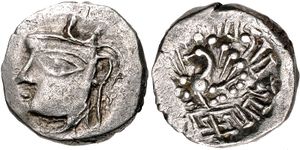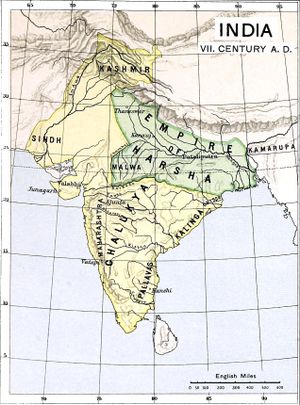هرشا
| هرشا | |
|---|---|
| مهاراجاديراجا | |
 عملة هرشاڤردانا، حوالي 606-647 م.[1] | |
| حاكم شمال الهند | |
| العهد | ح. 606 |
| سبقه | راجياڤردانا |
| تبعه | ياشوڤارمن |
| وُلِد | 595 م |
| توفي | 647 م |
| الأسرة | ڤردانا (پوشيابوتي) |
| الأب | پراباكرڤردانا |
| الديانة | الهندوسية والبوذية |
هرشا Harsha (ح. 590–647 م)، وتُعرف أيضاً بإسم هرشاڤردانا، كان امبراطور هندي حكم شمال الهند من 606 إلى 647 م. وكان ينتمي إلى أسرة ڤردانا؛ وكان ابن پراباكرڤردانا الذي هزم هون الخان الغزاة،[2] والشقيق الأصغر لـراجياڤردانا، ملك تهانيسر، هاريانا الحالية. في أوج قوة هارشا، غطت امبراطوريته معظم شمال وشمال غرب الهند، وامتدت شرقاً حتى كاماروپا، وجنوباً حتى نهر نرمدا؛ ولاحقاً اتخذ قنوج (في ولاية أتر پردش الحالية) عاصمة له، وحكم حتى 647م.[3] Harsha was halted by the south Indian Emperor Pulakeshin II of the أسرة چالوكيا, when Harsha tried to expand his Empire into the southern peninsula of India.[4]
The peace and prosperity that prevailed made his court a centre of cosmopolitanism, attracting scholars, artists and religious visitors from far and wide.[3] The Chinese traveller Xuanzang visited the court of Harsha and wrote a very favourable account of him, praising his justice and generosity.[3] His biography Harshacharita ("Deeds of Harsha") written by Sanskrit poet Banabhatta, describes his association with Thanesar, besides mentioning the defence wall, a moat and the palace with a two-storied Dhavalagriha (white mansion).[5]
الأصول
After the downfall of the Gupta Empire in the middle of the 6th century, North India was split into several independent kingdoms. The northern and western regions of India passed into the hands of a dozen or more feudatory states. Prabhakara Vardhana, the ruler of Sthanvisvara, who belonged to the Vardhana family, extended his control over neighbouring states. Prabhakar Vardhana was the first king of the Vardhana dynasty with his capital at Thaneswar. After Prabhakar Vardhana's death in 605, his eldest son, Rajya Vardhana, ascended the throne. Harsha Vardhana was Rajya Vardhana's younger brother. This period of kings from the same line has been referred to as the Vardhana dynasty in many publications.[6][7][8][9]
Sources suggest that Harsha, like the Guptas, was a member of the Vaishya Varna.[10] The Chinese traveller Xuanzang mentions an emperor named Shiladitya, who had been claimed to be Harsha.[11] Xuanzang mentions that this king belonged to "Fei-she". This word is generally translated as "Vaishya" (a varna or social class).[12]
البزوغ
Harsha's sister Rajyashri had been married to the Maukhari king, Grahavarman. This king, some years later, had been defeated and killed by king Devagupta of Malwa and after his death Rajyashri had been cast into prison by the victor. شقيق هرشا، راجيا ڤردانا، الذي كان آنذاك ملك تهانيسر, could not accept this affront on his family. So he marched against Devagupta and defeated him. إلا أن ششنكا ملك گودا في شرق البنغال، دخل ماگادا كصديق لـراجياڤردانا، ولكن في تحالف سري مع ملك ملوة. Accordingly, Shashanka treacherously murdered Rajyavardhana.[13] On hearing about the murder of his brother, Harsha resolved at once to march against the treacherous king of Gauda, but this campaign remained inconclusive and beyond a point he turned back. Harsha ascended the throne at the age of 16.
الدين
Like many other ancient Indian rulers, Harsha was eclectic in his religious views and practices. His seals describe his ancestors as sun-worshippers, his elder brother as a Buddhist, and himself as a Shaivite. His land grant inscriptions describe him as Parama-maheshvara (supreme devotee of Shiva), and his play Nagananda is dedicated to Shiva's consort Gauri. His court poet Bana also describes him as a Shaivite.[14]
According to the Chinese Buddhist traveler Xuanzang, Harsha was a devout Buddhist. Xuanzang states that Harsha banned animal slaughter for food, and built monasteries at the places visited by Gautama Buddha. He erected several thousand 100-feet high stupas on the banks of the Ganges river, and built well-maintained hospices for travellers and poor people on highways across India. He organized an annual assembly of global scholars, and bestowed charitable alms on them. Every five years, he held a great assembly called Moksha. Xuanzang also describes a 21-day religious festival organized by Harsha in Kannauj; during this festival, Harsha and his subordinate kings performed daily rituals before a life-sized golden statue of the Buddha.[14]
Since Harsha's own records describe him as Shaivite, his conversion to Buddhism would have happened, if at all, in the later part of his life. Even Xuanzang states that Harsha patronised scholars of all religions, not just Buddhist monks.[14]
المؤلف
Harsha is widely believed to be the author of three Sanskrit plays Ratnavali, Nagananda and Priyadarsika.[15] While some believe (e.g., Mammata in Kavyaprakasha) that it was Bana, Harsha's court poet who wrote the plays as a paid commission, Wendy Doniger is "persuaded, however, that king Harsha really wrote the plays ... himself."[15]
انظر أيضاً
المراجع
- ^ CNG Coins
- ^ India: History, Religion, Vision and Contribution to the World, by Alexander P. Varghese p.26
- ^ أ ب ت International Dictionary of Historic Places: Asia and Oceania by Trudy Ring, Robert M. Salkin, Sharon La Boda p.507
- ^ Ancient India by Ramesh Chandra Majumdar p.274
- ^ Vasudeva Sharana Agrawala (1969). The deeds of Harsha: being a cultural study of Bāṇa's Harshacharita. Prithivi Prakashan. p. 118.
- ^ Harsha Charitra by Banabhatt
- ^ Legislative Elite in India: A Study in Political Socialization by Prabhu Datta Sharma, Publ. Legislators 1984, p32
- ^ Revival of Buddhism in Modern India by Deodas Liluji Ramteke, Publ Deep & Deep, 1983, p19
- ^ Some Aspects of Ancient Indian History and Culture by Upendra Thakur, Publ. Abhinav Publications, 1974,
- ^ Chandra Mauli Mani (2005). A Journey Through India's Past. Northern Book Centre. p. 91. ISBN 978-81-7211-194-6.
- ^ Wendy Doniger (2006). Ratnāvalī. New York University Press. p. 15.
- ^ Shankar Goyal (2006). Harsha, a multidisciplinary political study. Kusumanjali. p. 122.
- ^ Bindeshwari Prasad Sinha (1977). Dynastic History of Magadha, Cir. 450-1200 A.D. Abhinav. p. 151.
- ^ أ ب ت Abraham Eraly (2011). The First Spring: The Golden Age of India. Penguin Books India. p. 86. ISBN 978-0-670-08478-4.
- ^ أ ب Harsha (2006). "The Lady of the Jewel Necklace" and "The Lady who Shows Her Love". Translated by Wendy Doniger. New York University Press. p. 18.
للاستزادة
- Reddy, Krishna (2011), Indian History, Tata McGraw-Hill Education Private Limited, New Delhi
- Price, Pamela (2007), Early Medieval India, HIS2172 - Periodic Evaluation, University of Oslo
- "Conquests of Siladitya in the south" by S. Srikanta Sastri
- Articles with hatnote templates targeting a nonexistent page
- Missing redirects
- Short description is different from Wikidata
- كتاب الدراما والمسرحيات الهنود القدماء
- People from Kurukshetra district
- 6th-century Indian monarchs
- 7th-century Indian monarchs
- Pushyabhuti dynasty
- كتاب الدراما والمسرحيات الهنود
- Indian Buddhist monarchs


